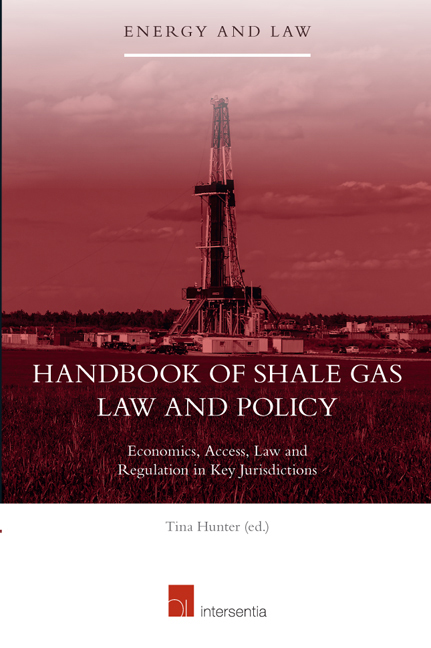Book contents
- Frontmatter
- Preface
- Contents
- List of Tables and Figures
- List of Authors
- Part I Overview and Introduction to Shale Gas Activities
- Part II Shale Gas Economics and Energy Security
- Part III Access to Shale Gas Resources
- Part IV Shale Gas Law and Regulation
- Regulating Hydraulic Fracturing
- Regulating Well Integrity
- The Environmental Challenges of Shale Gas Extraction
- An Overview of Shale Gas Law and Policy
- Shale Gas Law and Regulation in the United Kingdom
- Shale Gas Law and Regulation in North America
- Shale Gas Law and Policy in Australia
- Part V The Future of Shale Gas in the United Kingdom
- Index
Regulating Well Integrity
from Part IV - Shale Gas Law and Regulation
Published online by Cambridge University Press: 21 September 2018
- Frontmatter
- Preface
- Contents
- List of Tables and Figures
- List of Authors
- Part I Overview and Introduction to Shale Gas Activities
- Part II Shale Gas Economics and Energy Security
- Part III Access to Shale Gas Resources
- Part IV Shale Gas Law and Regulation
- Regulating Hydraulic Fracturing
- Regulating Well Integrity
- The Environmental Challenges of Shale Gas Extraction
- An Overview of Shale Gas Law and Policy
- Shale Gas Law and Regulation in the United Kingdom
- Shale Gas Law and Regulation in North America
- Shale Gas Law and Policy in Australia
- Part V The Future of Shale Gas in the United Kingdom
- Index
Summary
INTRODUCTION
The well is essential for the recovery of shale gas. There are five stages of the lifecycle of a well: planning, drilling, completion, production (including workover), and abandonment. At each stage of the well's lifecycle it is imperative that well integrity is maintained to ensure that no harm is caused to the environment or human life from a well blowout or loss of well control. In technical terms, the Norwegian standard NORSOK DS-010 defines well integrity as ‘the application of technical, operational and organisational solutions to reduce the risk of the uncontrolled release of formation fluids throughout the lifecycle of a well’. Therefore, well integrity refers to the design, installation and maintenance of a well and all of the associated equipment to a standard that ensure the safe and eff ective the fluids and injectants flowing into and out of a well bore from the time of the construction of the well until aft er the well is abandoned.
In 2013, there were 487,286 active gas wells in the USA alone (EIA, 2014) and almost 600,000 active oil wells. This is in addition to a similarly large but uncertain number of abandoned and suspended wells. Davies et al. citing a US EIA database list a total over 2.5 million wells onshore USA. Considering that the USA typically accounts for half or more of global activity, it might be expected that there are well over 1 million other oil and gas wells active outside the USA. Drilling activity is increasing year by year and technology strives also to keep old wells producing longer.
In the year 2012, over 45,000 new oil and gas wells were completed in the USA; at least 36,800 (circa 80%) of these were onshore and the vast majority of these were for unconventional (shale) oil and gas.
The picture diff ers outside the USA, where in 2013 there were only around 35,000 new oil and gas wells drilled. The overriding majority of these wells were also onshore conventional wells.
It has been estimated that global drilling will need to exceed 106,000 wells per year by 2020 in order to satisfy rising global demand and manage natural decline.
- Type
- Chapter
- Information
- Handbook of Shale Gas Law and PolicyEconomics, Access, Law and Regulation in Key Jurisdictions, pp. 213 - 236Publisher: IntersentiaPrint publication year: 2016

